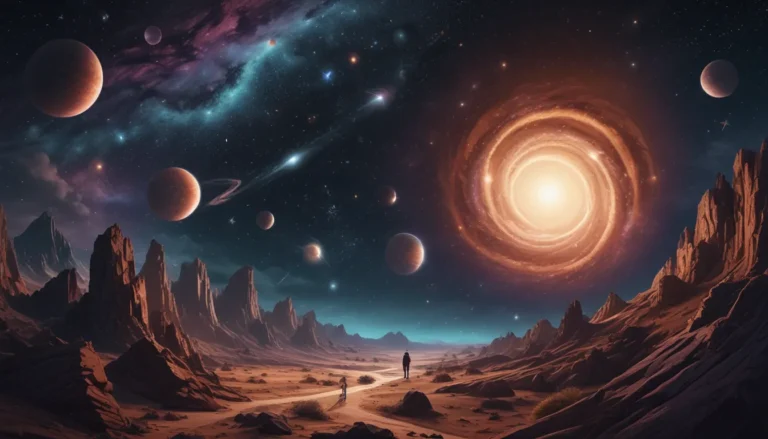The pictures we use in our articles might not show exactly what the words say. We choose these pictures to make you interested in reading more. The pictures work together with the words but don’t take their place. The words still tell you the important facts.
In the vast expanse of the universe, planetary atmospheres serve as a veil of wonder and intrigue, enveloping celestial bodies with their unique characteristics and dynamics. These ethereal layers dictate the very fabric of each planet, shaping climates, influencing weather patterns, and offering invaluable insights into the potential for extraterrestrial life. Join us on a captivating journey as we delve into 9 mind-blowing facts about planetary atmospheres, shedding light on the awe-inspiring diversity and complexity that exists beyond our Earthly realm.
Exploring the Cosmic Tapestry: Key Takeaways
- The atmospheres of planets are diverse and mesmerizing, from the fiery inferno of Venus to the tumultuous storms of Neptune. Each planet is a testament to the boundless wonders of our universe.
- Earth's atmosphere is a lifeline, providing a protective cocoon and essential oxygen for life to thrive. Studying the atmospheres of other planets enhances our appreciation for the intricate balance of our own planet.
Venus: A Hellish Inferno
Dubbed the "morning star," Venus boasts an atmosphere teeming with hostility towards life. Dominated by carbon dioxide and cloaked in sulfuric acid clouds, Venus experiences scorching temperatures surpassing 900 degrees Fahrenheit (475 degrees Celsius) due to a potent greenhouse effect.
Mars: The Frigid Red Planet
In stark contrast to Venus, Mars presents a thin and icy atmosphere composed primarily of carbon dioxide. With surface temperatures plummeting to a chilling average of minus 80 degrees Fahrenheit (minus 62 degrees Celsius), Mars' sparse atmosphere hints at a potentially habitable past.
Jupiter: A Realm of Mysteries
The colossal Jupiter houses a captivating atmosphere adorned with enigmatic wonders. The iconic Great Red Spot, a colossal storm spanning over 300 years, and ferocious winds clocking speeds of up to 400 miles per hour (644 kilometers per hour) create a turbulent celestial canvas.
Saturn: Rings of Gas and Ice
Saturn's allure lies in its ethereal rings and gas-dominated atmosphere. Hydrogen and helium reign supreme in this planetary realm, complemented by traces of methane and ammonia that add a touch of mystique to its celestial ballet.
Uranus: The Eccentric Wanderer
Gyrating on its side in a cosmic pirouette, Uranus boasts an atmosphere veiled in hydrogen, helium, and a dash of methane lending it a unique blue-green hue. Its unconventional tilt sets it apart from its planetary counterparts.
Neptune: Stormy Depths
At the fringes of our solar system, Neptune's turbulent atmosphere dances with colossal storms, including the awe-inspiring Great Dark Spot. Hydrogen, helium, and traces of methane paint Neptune's canvas in deep shades of blue, echoing its mysterious allure.
Earth: The Cradle of Life
Our beloved Earth showcases an atmosphere essential for nurturing life as we know it, with nitrogen, oxygen, and other vital gases sustaining a delicate balance. Acting as a guardian shield, Earth's atmosphere regulates temperature, shields against radiation, and provides the life-giving oxygen we breathe.
Mercury: A Whisper of an Atmosphere
Nestled closest to the sun, Mercury whispers with an almost nonexistent atmosphere, comprising trace gases continuously swept away by the solar wind. Intense temperature differentials plague Mercury, oscillating between scorching heat and chilling cold.
Pluto: A Cosmic Enigma
Despite its demotion from planetary status, Pluto's tenuous atmosphere exudes intrigue. Nitrogen dominates its rarefied atmospheric composition, with whispers of methane and carbon monoxide. Seasonal fluctuations in Pluto's atmosphere paint a picture of dynamic celestial rhythms.
Embark on a cosmic voyage through the wonders of planetary atmospheres, where each celestial body unfolds a story as unique as the stars themselves. From the swirling storms of Jupiter to the serene blues of Uranus, the mysteries of our universe beckon, inviting us to unravel their enigmatic tapestry. These revelations not only expand our cosmic perspective but also deepen our appreciation for the intricate dance of life and atmosphere on our own precious planet.
Conclusion: Unveiling the Cosmic Veil
Planetary atmospheres stand as testaments to the marvels of the cosmos, each harboring secrets waiting to be unlocked. Be it the blazing intensity of Venus or the tranquil whispers of Pluto, every planet embodies a symphony of atmospheric artistry. Delving into the complexities of these celestial envelopes not only enriches our understanding of distant worlds but also unveils the interconnected tapestry of our own earthly sanctuary. As we venture into the uncharted realms of the cosmos, let the enigmatic allure of planetary atmospheres inspire wonder and curiosity, fueling our quest for cosmic comprehension.
FAQs: Navigating the Astral Abyss
-
Which planet boasts the densest atmosphere?
Venus reigns supreme with its thick carbon dioxide-laden atmosphere, shrouded in insurmountable density. -
Do all celestial bodies host atmospheres?
While some like the Moon and Mercury bear faint or absent atmospheres, Earth, Mars, Venus, and Saturn flaunt substantial gaseous veils. -
What accounts for the diverse hues of planetary atmospheres?
The color palette of planetary atmospheres results from varied gas compositions, particulate presence, and light-scattering phenomena. -
Can we respire in alien atmospheres?
The majority of planetary atmospheres lack the breathable oxygen essential for humans, making Earth's life-sustaining atmosphere a rare gem amidst interstellar voids. -
Are there atmospheres beyond our solar confines?
Exoplanet explorations have unveiled atmospheres beyond our cosmic backyard, opening vistas to potentially habitable realms brimming with extraterrestrial promise.
Planetary atmospheres unveil a kaleidoscope of mysteries, offering tantalizing glimpses into the cosmic ballet of our solar system. As we gaze upon the vibrant hues and tempestuous airs of distant worlds, let curiosity guide us through the celestial expanse. Join us on a transcendent odyssey through planetary atmospheres, where every revelation sparks a newfound appreciation for the marvels of our universe, beckoning us to peer beyond the stars and delve into the boundless depths of space.






